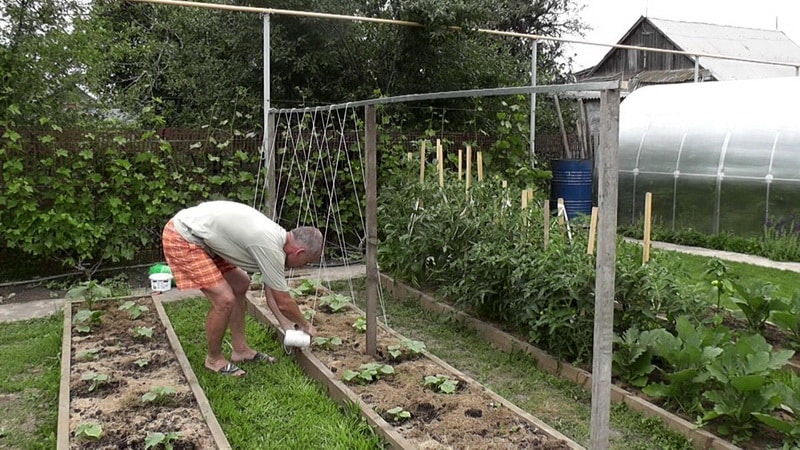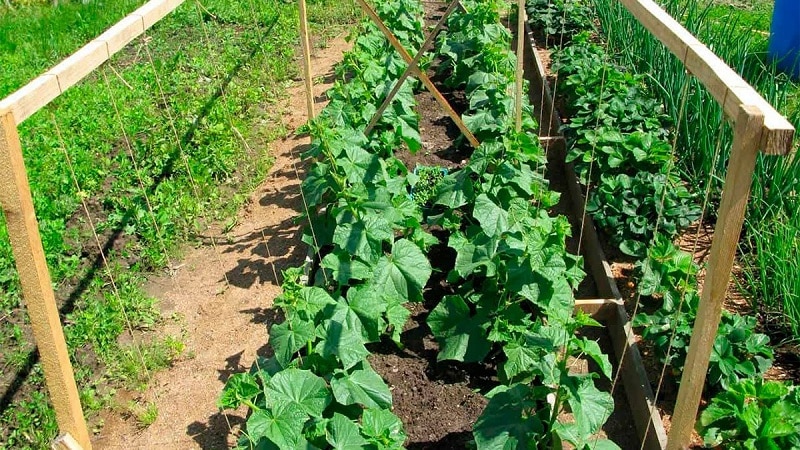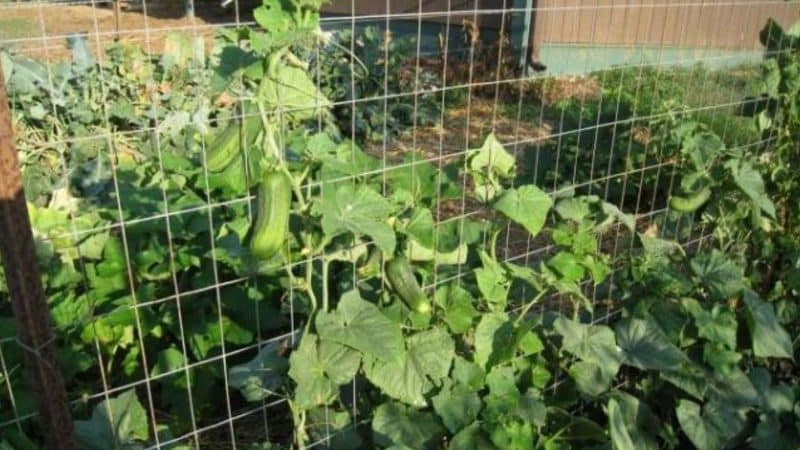Instructions for forming cucumbers on a trellis in the open ground for beginner gardeners
Cucumbers, like any climbing plants, tend to the sun. In search of support, they cling to neighboring plants and affect their growth. Therefore, when growing crops, summer residents build special trellis structures that help care for the plantings, form canes and collect fruits.
What is a trellis
Gardeners practice two methods of growing cucumbers - horizontal, when the plant is spread on the ground, and vertical, i.e. vines tie up to special devices (trellises) along which the plant climbs upward.

The vertical growing method has the following advantages:
- the vines are illuminated from all sides, are well ventilated, are saturated with oxygen, and are less likely to get sick;
- easier to harvest and care for the plant;
- it is easier for insects to pollinate cucumber flowers;
- crop ripening occurs 2 weeks faster than when using the horizontal method;
- beds with green vines on a trellis will decorate any garden and take up less space than with another growing method;
- the fruits are clearly visible on the vine, they are clean and do not rot, since they do not come into contact with wet soil, where there are many pathogens;
- when pests or signs of disease appear, easily handle treat the plant from all sides with the necessary preparations.
The only disadvantage is the need to build the structure itself. However, now you can purchase convenient devices that are easy to assemble and disassemble.They are removed from the garden bed for the winter until the next planting season.
Step-by-step instructions for growing cucumbers on trellises
Gardeners often use walls, fences, and poles as support, stretching wire over them. Let's look at how to build your own support structure.
How to make a trellis
To construct the structure, wooden or metal posts (30 mm) are dug in at opposite edges of the bed at a distance of 1.5-2 m from each other. The height of the columns from the ground surface is 2-2.2 m. A metal wire is pulled between them in 2-3 rows:
- first row - at a height of 15 cm from the surface of the ground;
- second – 1-1.2 m;
- third – 2 m.
One end of a strong twine is tied to the top row, and the other to a cucumber lash at a distance of 10 cm from the ground. Instead of twine, a mesh made of plastic or metal wire with a mesh size of 10-15 cm is becoming popular.
To prevent the mesh from sagging under the weight of ripening cucumbers, it is fixed to a horizontal jumper, forming a U-shaped structure with the mesh inside.
The hut-like structure is considered more stable.
Initial stage and preparation for planting
An important condition for obtaining a good harvest is the location of the trellis on the site. The structure is placed following the instructions:
- The support is installed on the sunny side of the site without drafts. You can protect the plant from the wind by planting corn or sunflowers.
- The ground surface should be flat or slightly sloping.
- The soil is prepared in advance for planting, fertilizing with organic fertilizing.
- The best site for cucumbers is considered to be the one where potatoes, peas, cabbage or tomatoes grew.
In spring, the soil under the cucumber bed is treated with boiling water.This will eliminate any bacteria that did not die during the winter and activate the heat production of the manure and compost.
Planting cucumbers
Cucumbers are planted in a garden bed with seeds or seedlings next to a trellis. The distance between plants should be for ordinary varieties from 15 cm, for bush plants – from 25 cm.
Before sowing in the ground, the seeds are heated for 3-4 hours at a temperature of +50...+60°C. Then soak in a weak solution of potassium permanganate (1 g per 100 ml of water) or garlic pulp for 20-30 minutes.
When the ground warms up to +15°C, the seeds are placed in the soil (4 seeds per 1 m) and covered with film until the first 5-6 leaves appear. Then the film is removed.
With the seedling method of growing, young plants are transplanted into a garden bed when they reach 15-20 cm and have 3 true leaves. Planting in the ground is carried out in late spring to reduce the risk of night frosts.
Care
To get a good harvest, you will have to monitor the fertility of the soil and regularly apply fertilizing, establish systematic and proper watering, loosen the beds and form bushes. If you follow agricultural techniques, the yield may even exceed the indicators declared by the manufacturer.
Cucumbers are moisture-loving plants, so seedlings are watered every 4-5 days. 1 m² of land should require 3-6 liters of water.
Important! It is necessary to water only with warm water. Cold water provokes the development of fungal diseases, and supplying water from a hose in one stream exposes the roots.
During ripening and harvesting, increased fertilizing is necessary. For this use:
- potassium nitrate solution – 30 g per 10 liters of water;
- herbal infusion diluted with water 1:5;
- ash extract - 1 tbsp. on a bucket of water;
- spraying leaves with urea solution - 10 g per bucket of water.
Formation of cucumbers on a trellis in open ground
The choice of method for forming a cucumber primarily depends on which group it belongs to: traditional varieties that produce the harvest evenly from the entire plant, or modern, low-climbing varieties that form the harvest on the main stem.

Features of the formation of varietal cucumbers, hybrids and bouquet varieties
In varietal cucumbers, predominantly male flowers appear on the main stem. Pinching the top of the plant above the fifth leaf stimulates the formation of side shoots. They produce a larger number of female inflorescences, from which the ovaries are formed.
Modern hybrids use a slightly different approach. They produce a sufficient number of female flowers. Co.When 3-5 true leaves appear on the stem, all shoots and buds that can slow down the development of the plant are removed from their axils. This technique is called blinding. In this case, all forces will be directed to the growth of the main stem. When the stem reaches the upper horizontal line, it is thrown to the other side of the trellis. When the stem on the other side grows another 60-70 cm from the top of the trellis, the top of the hanging plant pinching.
Parthenocarpic hybrids, in which flowers are formed in whole bunches, require more careful care than their less productive counterparts. Bundle cucumbers are characterized by simultaneous and abundant formation of buds on the main and side shoots. Therefore, due to simultaneously developing fruits, the bush can become very weak, and some of the fruits will eventually become deformed or disappear from lack of nutrition.
To avoid troubles, special technology is used to form bouquet cucumbers.At 3-4 nodes of the lower tier, the rudiments of the lateral lashes and ovaries are plucked off. In the remaining nodes, the rudiments of the lateral shoots are blinded, but the ovaries are not touched. After fruiting on the main shoot ends, the plant is fed well so that new side shoots begin to form. Soon the secondary shoots will begin to be overgrown with fresh ovaries, which are usually no less than during the first wave of the harvest.
Attention! Feed the plant in the morning or evening to avoid chemical burns. It is better to apply fertilizer after watering.
How to shape cucumbers
You can form a plant:
- in 1 stem: remove all side shoots at the same time as damaged leaves and inflorescences;
- in 2 stems: remove stepsons in the first three nodes, left above the fourth;
- in 3 stems: the stepsons are removed at the first two nodes.
Trimming lashes
Pruning of vines begins 3-5 weeks after planting in the ground and the beginning of growth. By this moment, the height of the plant should reach at least 0.5 m. Pruning is carried out every 2 weeks. This helps the plant retain nutrients for greater fruit production.
Important! If you start pruning when the plant height is up to 0.5 m, it will not have time to develop, and you may be left without a harvest at all.
What is the difference between forming on a trellis in a greenhouse?
Growing cucumbers in a greenhouse and open ground are two different things, so you should carefully select seeds for planting. Among the most popular varieties of cucumbers you can find varieties that do not require formation or are single-stemmed.
In the greenhouse, the lower part of the stems should not be allowed to thicken, otherwise excess moisture will arise, which contributes to the development diseases. Every 10-14 days, the 2 lower leaves are torn off, as they take a lot of juice.You should not cut off more than 2 leaves so as not to weaken the lash.
When growing in greenhouses, the stem is always directed upward, regardless of how many lashes the plant is formed into.
The top that reaches the ceiling of the greenhouse must be plucked off. Or you can do it differently - fold the bare stem from below (previously fruits, shoots, leaves were removed from it) in a loop. To do this, it is lowered down the twine and the resulting loop is tied to the whip on the twine. The top will drop and there will be room for further growth.
Tips and secrets of experienced summer residents

Experienced gardeners always have useful tips for beginners, proven over the years:
- You need to start forming the plant in the morning. Within a day, the wounds from pinching will have time to heal.
- Leaves and vines should not be turned in the opposite direction. A forcibly deployed shoot can stop growing, turn yellow, or even die.
- Trimming of lashes is performed only with clean tools. This way you can avoid infecting the plant.
- You should not plant cucumbers in one place for several years in a row. Pests and pathogens accumulate in the soil.
Conclusion
Recently, many gardeners have opted for growing cucumbers on trellises. When using a support, there is no need to bend over again when harvesting. When spraying plants on structures, the solution spreads evenly onto the stems and leaves. In addition, space is saved significantly. All this speaks in favor of using trellises.